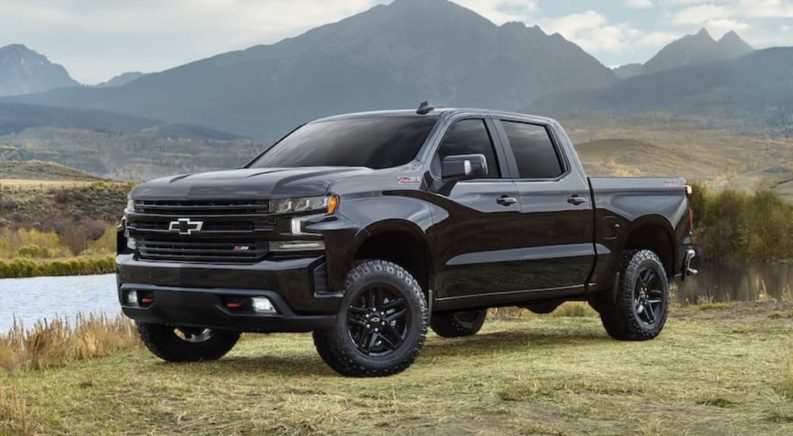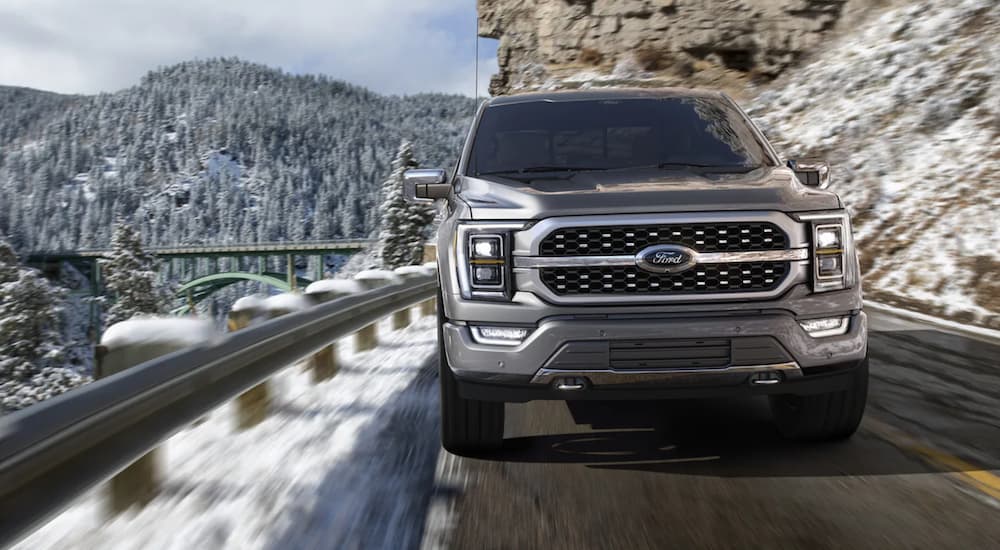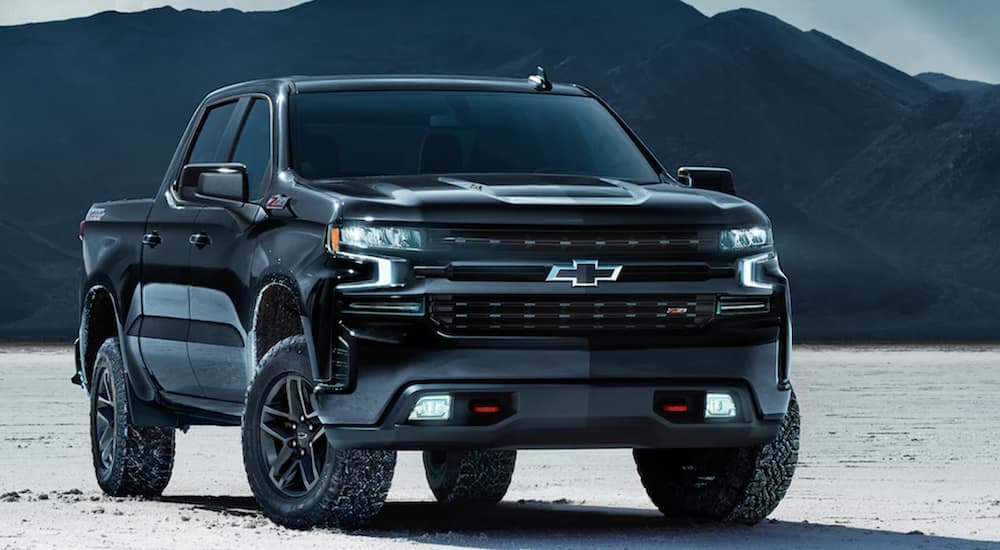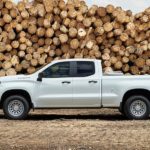Have you ever heard the phrase, “A house divided?” Sports fans often use the phrase when a person supports one team while their partner supports their biggest opponent. In the truck world, you can easily say it’s a house divided when it comes to Chevy and Ford, two of America’s leading automakers. Die-hard Chevy fans swear by the bowtie while Ford loyalists are devoted to the legendary blue badge. But what happens when you compare two of the newest trucks in the lineup – the 2021 Chevy Silverado 1500 vs 2021 Ford F-150?
Whether you have a Chevy or a Ford sitting in your driveway, there’s no question that the 2021 Silverado and the 2021 F-150 are capable workhorses. It’s this capability that often divides buyers, which is what inspired this closer look at what you’ll find under the hood of these full-size road warriors. Will the differences keep the house divided, or are there enough similarities to say that both trucks are equally capable and innovative? Let the battle of the full-size trucks begin!
Power and Capability
The 2021 Silverado and the 2021 F-150 are two of the most capable trucks you’ll find on the road. Chevy and Ford unleashed a lot of new features and technology on the trucks, with the Silverado now offering the six-function Multi-Flex Tailgate that makes it easier to load, unload, and haul cargo in the bed. You’ll also find increased trailering capability and trailering technology as well as more standard and available features like wireless Apple CarPlay and Android Auto on the iconic Chevy.
Like Chevrolet, Ford unleashed every trick in its wheelhouse to deliver one of the most capable light-duty trucks in America. Focusing on productivity and capability, Ford added a new hybrid powertrain to the 2021 F-150 lineup and redesigned the exterior to make it more aerodynamic and efficient. The interior also boasts the latest technology and a suite of tools that make life easier when you’re behind the wheel.
But how do the F-150 and the Silverado compare in terms of power and performance? Will the addition of the F-150’s hybrid powertrain give Ford the lead? It’s safe to say that both Chevy and Ford deliver plenty of powertrain options that reflect decades of innovation and engineering to deliver exceptional trucks that can handle any job with ease. For Chevy, this innovation extends across nine powertrain configurations and, for Ford, it extends across its six-engine lineup.
2021 F-150
On the 2021 F-150, the base engine is the 3.3-liter V6 that delivers a modest 290 horsepower and 265 lb-ft of torque. This isn’t the power the F-150 is known for, which is exactly why most drivers opt for one of the five other powertrains. The 2.7-liter V6 EcoBoost with automatic start-stop technology delivers 325 horsepower and 400 lb-ft of torque, while the 5.0-liter V8 increases this power to 400 ponies and 410 lb-ft of torque.
Ford continues to raise the bar with its 3.5-liter V6 EcoBoost, the 3.0-liter Power Stroke V6 turbo diesel, and the all-new 3.5-liter PowerBoost Full Hybrid V6 engine. The 3.5-liter V6 delivers 400 horsepower and 500 lb-ft of torque to give the F-150 exceptional power whether you’re cruising the highway, climbing a steep grade, or towing a heavy load. The diesel engine is the most efficient, delivering 250 horsepower and 440 lb-ft of torque.
This power doesn’t compare to Ford’s all-new hybrid V6 that makes the F-150 the only light-duty full-size truck with a hybrid powertrain available on every trim. Equipped with a PowerBoost system to enhance the V6’s power, the hybrid is the most powerful engine available and delivers 430 horsepower and 570 lb-ft of instantaneous torque. This sheer power makes the hybrid capable of towing up to 12,700 pounds, which is only a slight decrease from the truck’s best-in-class 14,000-pound towing capacity when equipped with the 3.5-liter EcoBoost.
2021 Silverado
The 2021 Silverado offers nine powertrain configurations that come equipped with or without Chevy’s exclusive Active or Dynamic Fuel Management systems. Chevy first introduced Active Fuel Management (AFM) in 2005 and continuously made improvements to the technology, which paved the way for the introduction of Dynamic Fuel Management (DFM) in 2019. AFM optimizes the engine’s power and performance by alternating between the engine’s eight and four-cylinder modes. DFM takes this a step further by offering 17 cylinder patterns to continuously optimize efficiency and deliver the power needed at any speed and in any condition.
The AFM and DFM systems, along with automatic start-stop technology, give the Silverado its nine powertrain configurations. These options begin with the 4.3-liter V6 with AFM that delivers 285 horsepower and 305 lb-ft of torque with a max trailering capacity of 7,900 pounds on two-wheel drive models. The 2.7-liter turbo engine with AFM sees a boost in power to 348 lb-ft of torque and 310 horsepower that give the truck the capability to haul up to 9,600 pounds.
The 3.0-liter turbo diesel engine and the 6.2-liter V8 with DFM are evenly matched in the torque department and deliver 460 lb-ft, but you’ll see a wide variation in power and capability with the diesel producing 277 horsepower compared to the V8 at 420 horsepower. This also results in a significant difference in trailering capability, with the diesel topping out at 9,500 pounds compared to the V8 and 13,300 pounds. While the 6.2-liter V8 offers the Silverado’s best-trailering capability, you’ll still have plenty of power with the 5.3-liter V8 with or without AFM or DFM. These four configurations deliver 355 horsepower and 383 lb-ft of torque, as well as a trailering capability that ranges between 10,000 and 11,500 pounds.
What It Means
Chevy’s Active and Dynamic Fuel Management systems are a hot topic in the automotive industry and reflect Chevy’s dedication to offering cutting-edge technology that will make trucks like the Silverado more efficient and capable than ever before. While you won’t find anything similar on the Ford F-150, that isn’t to say that Ford doesn’t share the same level of commitment to building powerful workhorses that can handle any job without breaking a sweat. Both the Silverado and the F-150 can easily get the job done on their own merit.
While Chevy has the AFM and DFM technology, it lacks a hybrid option that the F-150 certainly makes up for in its 2021 lineup. The full hybrid powertrain on the 2021 F-150 makes the truck the first of its kind to offer a hybrid option on every available trim. The F-150 hybrid is certainly a powerhouse, but there is already stiff competition in the works after GM announced the upcoming Silverado EV that skips the hybrid powertrain altogether to give drivers a completely electric full-size truck. Needless to say, Ford is also working on its debut electric F-150.
This fierce competition is incredibly beneficial to drivers. Why? Because this level of competition pushes Ford and Chevrolet to constantly develop better, more innovative technology to deliver exceptional trucks that exceed every expectation. As Ford and Chevrolet push the envelope, drivers reap the benefits of getting behind the wheel of a Silverado or an F-150 loaded with the newest technology. Of course, the steep competition also means that America will always be a house divided, at least when it comes to beloved brands like Chevy and Ford.






